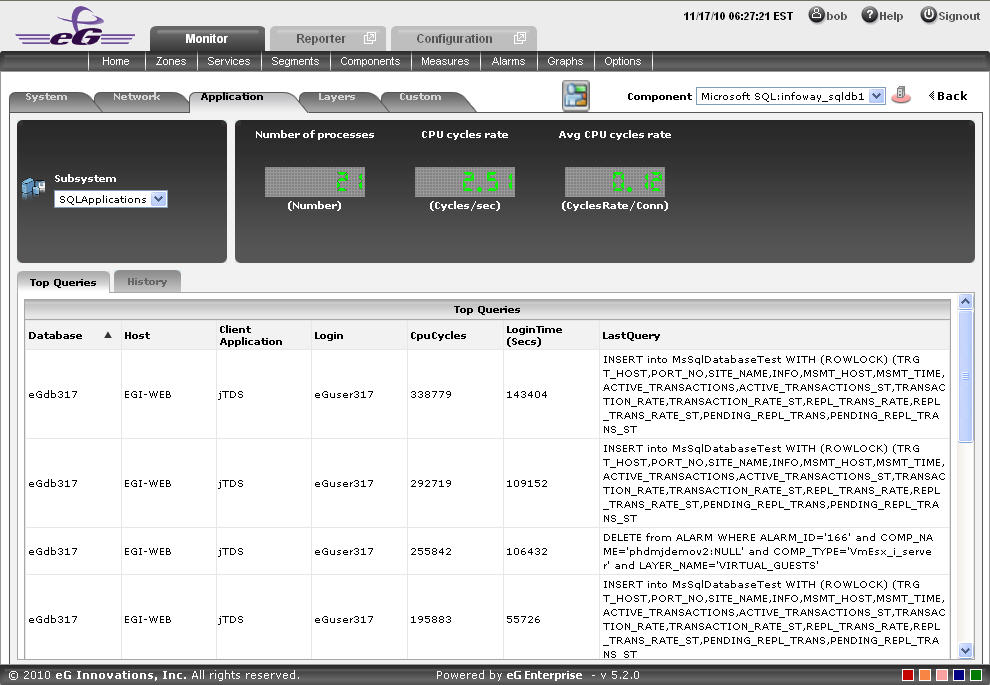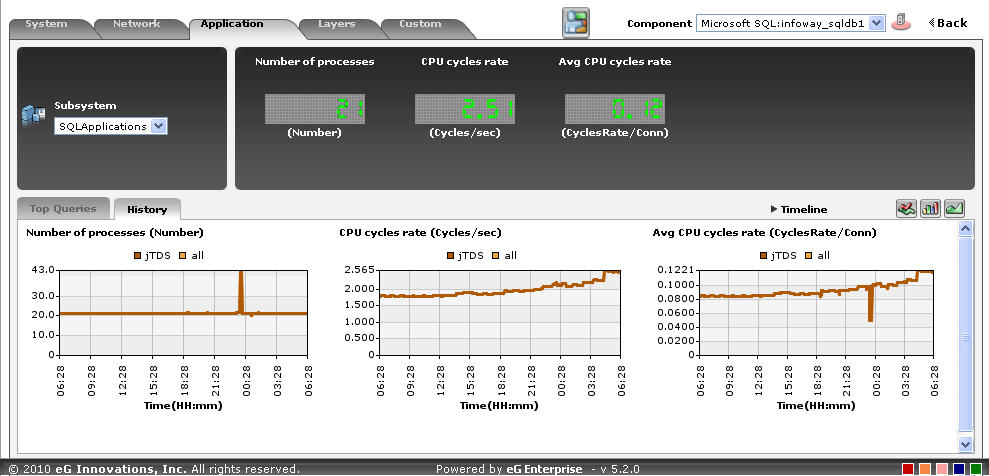SQLApplications
Select the SQLApplications option from the Subsystem list to know how well the applications are being used by the Microsoft SQL application, Upon selecting this Subsystem, Figure 1 will appear.

Figure 1 : The SQLApplications Dashboard
The contents of the SQLApplications dashboard are as follows:
- For an easy and single glance view of certain measures like Number of processes, CPU cycle rate and Avg CPU cycles rate, a digital graph section is included. When a digital graph is clicked, the corresponding layer-test combination which reports that particular measure will be displayed from the layer model page of the Microsoft SQL application.
- From the Top Queries tab page, you can infer the queries that have been made to the databases from the client application. By default, the queries listed in this tab page are sorted in alphabetical order of the Database. If need be, you can change the sort order so that the databases are arranged in, say, the descending order of values displayed in the CPUCycles column. To achieve this, simply click on the column heading – CPUCycles. Doing so tags the CPUCycles label with a down arrow icon - this icon indicates that this tab page is currently sorted in the descending order of the CPU cycles. To change the sort order to ‘ascending’, all you need to do is just click again on the CPUCycles label or the down arrow icon. Similarly, you can sort the process list based on any column available in this tab page.
-
The History tab page, by default, displays time-of-day graphs revealing how well the application has been performing over a default period of 24 hours. If the eG agent reports any abnormal behavior of the Microsoft SQL application, these graphs will help determine when exactly in the last 24 hours the abnormality occurred. This default duration of 24 hours can be overridden using the following steps:
- Click on the
 icon at the top of the Application Dashboard.
icon at the top of the Application Dashboard. - In the Dashboard Settings window that appears, select History Graph from the Default Timeline for list.
- Then, choose a Timeline for the graph.
- Finally, click the Update button.

Figure 2 : The history tab page of the Microsoft SQL Applications Dashboard
- Click on the
- A careful study of this graph over time periods longer than 24 hours, can reveal intermittent breaks (if any) in the number of processes and the CPU cycle rate of the databases. To ensure that all graphs plot values for longer time periods, click on the Timeline link at the right, top corner of the History tab page, and then change the timeline using the calendar that pops out. To modify the timeline for a particular graph alone, click on the graph to enlarge it, and alter the timeline in the enlarged mode. Besides the timeline, you can even change the graph dimension (3d / 2d) in the enlarged mode.
-
Sometimes, you might have to periodically determine the percentage of time for which the Microsoft SQL application experienced problems relating to the databases. To determine such problems, summary graphs of the SQL applications measures are useful. To view summary graphs in the History tab page, click on the
 icon at the right, top corner of the History tab page. These summary graphs reveal the percentage of time during the last 24 hours (by default) the Microsoft SQL application has experienced issues related to the SQLapplications. To override this default timeline, do the following:
icon at the right, top corner of the History tab page. These summary graphs reveal the percentage of time during the last 24 hours (by default) the Microsoft SQL application has experienced issues related to the SQLapplications. To override this default timeline, do the following:- Click on the
 icon at the top of the Application Dashboard.
icon at the top of the Application Dashboard. - In the Dashboard Settings window that appears, select Summary Graph from the Default Timeline for list.
- Then, choose a Timeline for the graph.
- Finally, click the Update button.
- Click on the
- To perform the summary analysis over a broader time window, click on the Timeline link at the right, top corner of the History tab page and change the timeline; this will alter the timeline for all the graphs. To change the timeline of a particular graph alone, click on the graph to enlarge it, and then alter its timeline. Also, by default, hourly summaries are plotted in the summary graph; you can configure these graphs to plot daily/monthly summaries instead by picking the relevant option from the Duration list in the enlarged mode. Here again, the graph dimension (3d / 2d) can be altered.
-
Similarly, you can analyze uptime trends by viewing trend graphs in the History tab page. For this, click on the
 icon at the right, top corner of the tab page. These trend graphs, by default, plot the minimum and maximum values registered by every SQL application-related measure during every hour for the last 24 hours. The default duration of 24 hours can be overridden using the procedure discussed below:
icon at the right, top corner of the tab page. These trend graphs, by default, plot the minimum and maximum values registered by every SQL application-related measure during every hour for the last 24 hours. The default duration of 24 hours can be overridden using the procedure discussed below:- Click on the
 icon at the top of the Application Dashboard.
icon at the top of the Application Dashboard. - In the Dashboard Settings window that appears, select Summary Graph from the Default Timeline for list.
- Then, choose a Timeline for the graph.
- Finally, click the Update button.
- Click on the
- At any point in time, you can switch to the measure graphs by clicking on the
 button.
button. -
Typically, the History tab page displays measure, summary, and trend graphs for a default set of measures. If you want to add graphs for more measures to this tab page or remove one/more measures for which graphs pre-exist in this tab page, then, do the following:
- Click the
 button at the top of the dashboard.
button at the top of the dashboard. - The Dashboard Settings window then appears. From the Module list of Figure 20, pick Application, choose SQLApplication as the Sub-System, and then, select History Graph from the Add/Delete Measures for list.
- The measures for which graphs pre-exist in the History tab page will be automatically displayed in the Existing Value(s) list. To delete a measure, and in effect, its corresponding graph as well, select the measure from the Existing Value(s) list, click the Delete button, and then click the Update button.
- To add a new graph, first, pick the Test that reports the measure for which a graph is to be generated.
- Next, select the Measure of interest.
- Provide a Display name for the measure. Then, click the Add button to add the measure to the Existing Values(s) list. Finally, click the Update button.
- This will add a new measure, summary, and trend graph for the chosen measure to the History tab page.
Note:
Only users with Admin or Supermonitor privileges can enable/disable the system, network, and application dashboards, or can customize the contents of such dashboards using the Dashboard Settings window. Therefore, whenever a user without Admin or Supermonitor privileges logs into the monitoring console, the
 button will not appear.
button will not appear. - Click the
To perform trend analysis over a longer time span, click on the Timeline link at the right, top corner of the History tab page and change the timeline; this will alter the timeline for all the graphs. To change the timeline of a particular graph alone, click on the graph to enlarge it, and then alter its timeline. In addition to the timeline, the graph dimension (3d / 2d), the graph Duration, and the Graph type can also be changed in the enlarged mode. By default, the graph Duration is Hourly, indicating that trend graphs plot hourly trend values by default. To ensure that these graphs plot the daily/monthly trend values instead, select the relevant option from the Duration list. Similarly, as already mentioned, trend graphs plot only the minimum and maximum values registered by a measure during the specified timeline. Accordingly, the Graph type is set to Min/Max by default in the enlarged mode. If you want the trend graph to plot the average trend values instead, set the Graph type to Avg. On the other hand, to configure the trend graph to plot the sum of trends set the Graph type to Sum.
Note:
In case of descriptor-based tests, the Summary and Trend graphs displayed in the History tab page typically plot the values for a single descriptor alone. To view the graph for another descriptor, pick a descriptor from the drop-down list made available above the corresponding summary/trend graph.